|
Wolverhampton’s Centenary Civic Exhibition
Held
at the Civic and Wulfrun Halls, 18th to the 25th
September, 1948
Incorporating the Health of the People Exhibition
The Centenary exhibition in the
Civic Hall was a showcase for the work of the
Corporation and its various departments. There were 29
stands in the hall, each dedicated to the functions of a
particular department.
There was an admission charge of
six pence for everyone, except children who were
accompanied by an adult. Refreshments were available in
the crush room at the rear of the Civic Hall and seats
were available on the balcony. Music in the form of
gramophone records was supplied by W. H. Podmore & Son
Limited, of Market Street. There was also an organiser’s
office, staffed by Mr. J. E. Holdsworth, of Ultra
Displays Limited, situated on the mezzanine floor. |
|
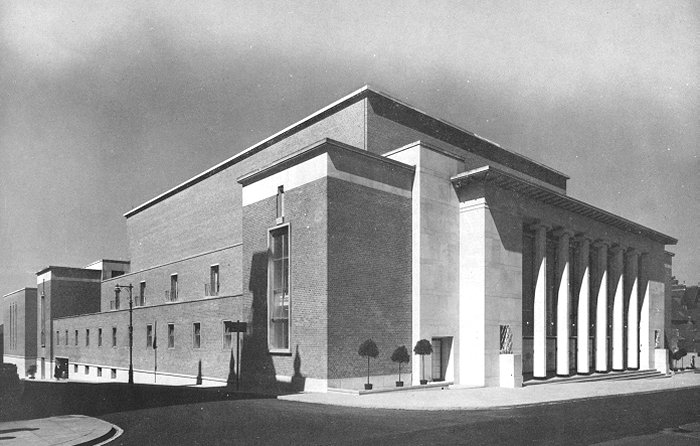
The Civic Hall, as built. |
|
Panels at the entrance of the
exhibition introduced the visitor to the many activities
of the various local government departments, which were
dealt with separately on the various stands. The
displays were as follows:
Stand No.1.
Information Bureau. Was operated by the Public Relations
and Development Department, responsible for the
dissemination of information, and the ascertaining of
public opinion, on every aspect of the Corporation's
activities. The department also produced guides and
informative literature and maintained a liaison between
the press and the Corporation.
Stand No. 2.
Town Clerk's Department. The Town Clerk was the Chief
Administrative Officer of the Corporation who advised
the Council on legal and other matters. He also kept the
seal and all minutes and records of the Council and
Committees and was responsible for the polling
arrangements at all elections.
Stand No. 3.
Borough Treasurer's Department. On this stand there were
diagrams and statements to show how the activities of
the Corporation were financed, together with some of the
office machinery used in the Borough Treasurer's
Department, which was responsible for the general
financial and accounting control of all Corporation
activities.
Stand No. 4.
Licensing and Taxation. The Licensing and Taxation
Department of the Town Clerk's Office carried out the
registration of road vehicles, the issuing of road fund
licences, drivers' licences, and local taxation
licences. The Department was created in 1921 after the
passing of the Roads Act. 1920.
Stands Nos. 5, 6, 7
and 8. Borough Engineer's Department. The
Department of the Borough Engineer and Surveyor oversaw
the design and erection of Corporation houses, schools
and public buildings, the construction of roads,
bridges, drainage, the maintenance of rivers, street
sweeping and gully emptying. Also the layout and
maintenance of parks and playing fields, allotments and
cemeteries, slum clearance and redevelopment.
The display included details of the
1,400 houses that had been completed and occupied since
1945, along with some schools and public buildings, and
an impression of the possible development of a Civic
Centre. |
|
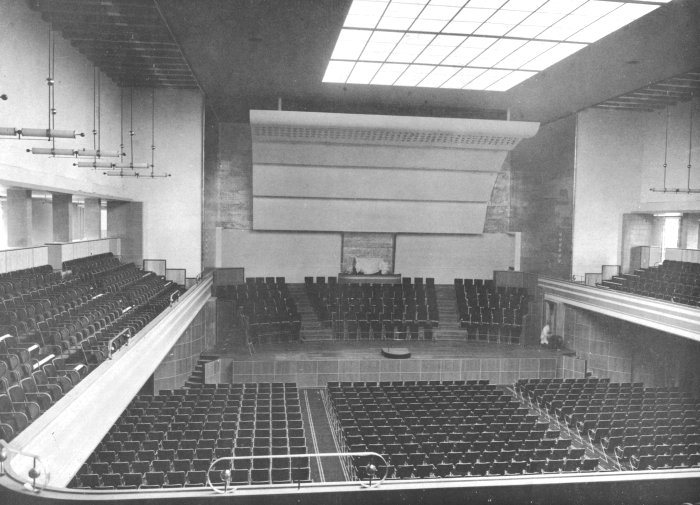
The Civic Hall. |
|
Stand No. 9.
Public Baths. Included displays about the Central
and the Heath Town Public Baths, public wash house
facilities and the associated water filtration
plant.
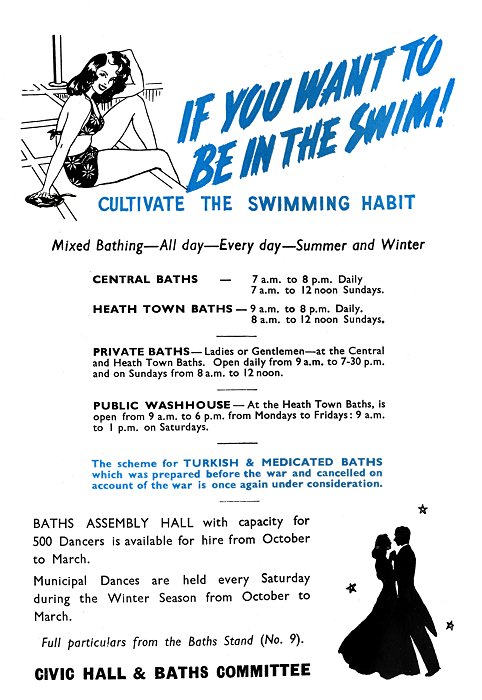
Stands 10 and
11. Education and Civic Restaurants and
School Meals Service. There were details of the
service of wholesome and attractive meals in the
Civic Restaurants and for children at school. Plans
included free school meals and the provision of a
kitchen and dining room in each school.
The story of education in
Wolverhampton required more space than was
available, but priority was given to the display of
details about the forthcoming education week on the
24th to the 30th October, when people could inspect
the schools during a programme of events.
Stand No. 12.
Weights and Measures Department. The display about
the department featured the inspection of weights,
measures, weighing and measuring instruments used in
shops, warehouses, factories, and petrol pumps. Also
the checking of the weight or measure of all kinds
of foodstuffs, coal, sand and ballast, on sale at
traders' premises or in the course of delivery to
customers.
Stand No. 13.
Police Force. The display included the recently
introduced ultra high frequency radio communication
network, the police telephone network, the
photography department, the scientific investigation
of crime, and the project to build a new police
headquarters that was shelved in the Second World
War. |
|
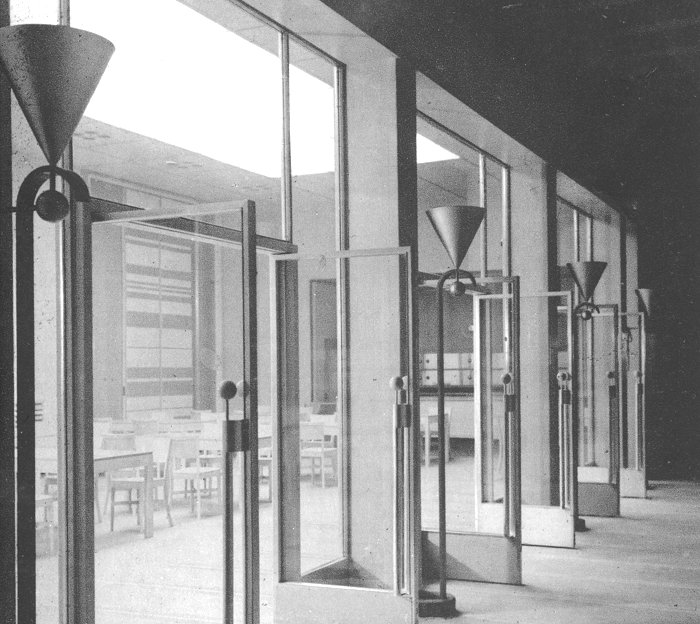
The entrance to the Refreshment
Room from the Crush Room in the Civic Hall. |
|
Stand No. 14.
Transport Department. There were details of the trolley
bus network, model trolley buses running on a circular
track and a map of the bus services together with a
switch panel that could be worked by visitors to display
various points on the map.

Stand No. 15.
Airport. Wolverhampton Municipal Airport covered nearly
90 acres and was opened in 1938. There were details of
the airport on display, along with a brief history.
Stand No. 16.
The National Association of Local Government Officers,
trades union’s display featured the association’s
educational facilities for its 178,000 members, its
provident schemes, its building society, holiday camps,
etc.
Stand No. 17.
Cleansing Department. The display featured the work of
the department including the collection and disposal of
refuse, paper salvage, and the collection of food
salvage for the production of pig food.
Stand No. 18.
Market, Abattoirs and Cold Stores Department. This stand
featured the retail market hall, the wholesale market,
the abattoirs and their role in the manufacture of
grease, fertilisers and meat and bone meal, and the cold
stores and ice manufactory with approximately 80,000
cubic feet of storage space, used primarily for the
preservation of meat, butter, cheese, eggs, fruit
juices, etc. There was also a section on the low
temperature storage of glands, spinal cords and liver
for processing into medicinal products and the
manufacture of commercial ice.
Stand No. 19.
Public Libraries. The display included details of
Wolverhampton Public Library and its lending, reference,
and reading rooms that contained around 40,000 volumes
and 7,000 children’s books. There were also details of
the branch libraries at Low Hill and Heath Town and the
forthcoming branch libraries at Elston Hall School and
at Penn.
Stand No. 20.
Sewage Works. Details were given of the main sewage
treatment plant at Barnhurst, and branch works at Merry
Hill and Coven Heath. |
|
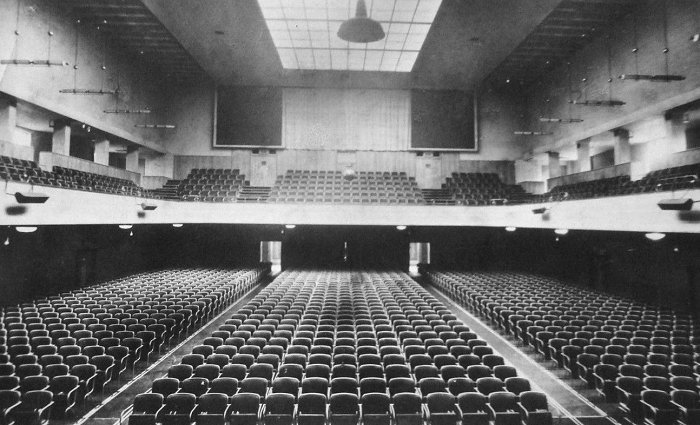
Another view of the Civic
Hall. From an old postcard. |
|
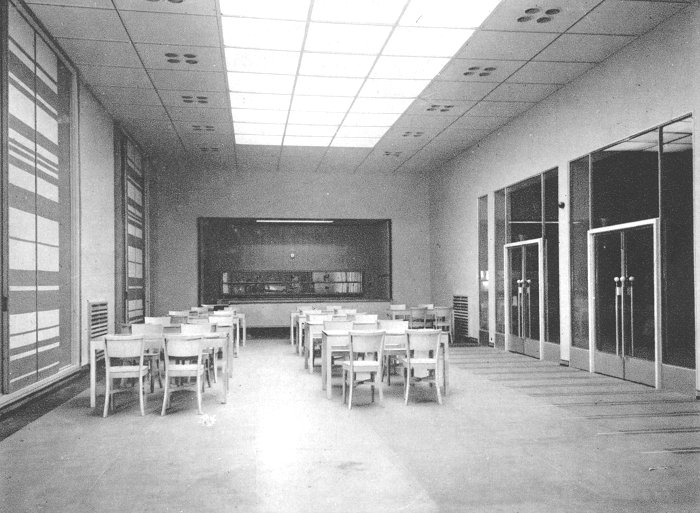
The Refreshment Room in the Civic
Hall. |
|
Stand No. 21.
Fire Brigade. There was a display about Wolverhampton
Fire Brigade which became a municipal service on April
1st of that year.
Stand No. 22.
The Water Undertaking. The story of the undertaking was
displayed, which at the time supplied about 8,750,000
gallons of water per day to a population of 240,000, in
an area of 30 square miles, including Wolverhampton,
parts of Staffordshire and Shropshire, and the supply
works at Cosford, Tettenhall, Dimmingsdale and Hilton.
Stand No. 23.
The Children's Department. The department, which was
established in July of that year, aimed to help children
who were without a normal family upbringing. The stand
included sections on foster-homes, New Cross Nursery and
the Cottage Homes.
Stand No. 24.
The Ambulance Service. The display included sections on
hospital, factory and police ambulances, and the
formation of the Civil Defence Ambulance Service during
the war. Details were included about the Municipal
Ambulance Service, operated in conjunction with the Fire
Brigade and based at The Gables, Penn Road.
Stand No. 25.
Welfare Services Department. Details were given about
the department and the Children's Department which both
came into being on the 5th July of that year.
Stand No. 26.
The Civic Hall. This section described both the Civic
and Wulfrun Halls and included details of concerts,
plays and dances, annual festivals of music and drama,
modern and old time dancing contests etc.
Stand No. 27.
Parks and Cemeteries. The display by the Borough
Engineer's Department described the 200 acres or so of
parks and open spaces in the Borough, the planting of
street trees, and the cultivation of traffic islands,
etc. There was a section on the new lawn cemetery at
Bushbury and the cultivation and sale of fruit and
vegetables and the sale of plants to allotment holders.
Stand No. 28.
Central Floral Exhibit. This consisted of a fountain
surrounded by a display of flowers and plants, kindly
lent by Birmingham Corporation.
Stand No. 29.
Art Galleries and Museums. The display included details
of the art works in the collection at the Art Gallery,
and the examples of Staffordshire and Wedgwood Pottery,
Bilston and Birmingham Enamels in the museum. |
|
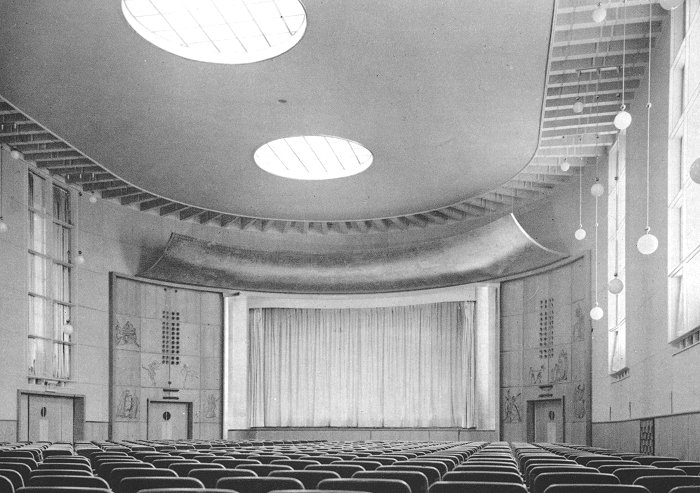
Wulfrun Hall. |
| The Wulfrun Hall contained a touring section of an
exhibition called 'Health of the People', which told the
story of the progress in improving public health since
the first Public Health Act of 1848, up to the
inauguration of the National Health Service on July 5th
1948. There was also a cinema where interesting films
were shown at frequent intervals on the stage of the
Wulfrun Hall. The
centenary exhibition was organised by the following
sub-committee, consisting of:
|
Councillor H. T. Fullwood – Chairman |
|
Councillor J.
Beattie |
|
Alderman H. E. Lane – Mayor |
|
Councillor J. C.
Homer |
|
Alderman W. Lawley |
|
Councillor A. G.
Goodman |
|
Alderman J. Clark, J.P. |
|
Councillor W. J.
Rawlins |
|
Alderman Sir Charles A. Mander, Bart., D.L.,
J.P. |
|
Councillor F. H.
Thompson |
|
Alderman C. B. V. Taylor, J.P |
|
|
| |
|
|
|
Co-opted
members: |
|
|
|
Alderman A. Davies, J.P. |
|
E. Ashley Milner |
| F. J.
Bradford |
|
D. Preston |
| J.
Brock Allon, B.A. – Town Clerk |
|
J. G. Reed |
| R. F.
Hudson |
|
J. D. Swallow |
|
| The catalogue for the events included the following
interesting account, entitled ‘One Hundred Years a
Borough’ by J. Brock Allon, B.A., Town Clerk and
Solicitor to the Corporation, and Clerk of the Peace. |
|
On the
Continent, the year 1848 was a year of revolution and
upheaval during which men struggled for political rights
and national freedom. G. M. Trevelyan has described it
as the turning point at which modern history failed to
turn.
But the
history of Wolverhampton did take a turn when a Charter
of Incorporation gave the people effective control of
their own affairs. It is true that at the time the
franchise was severely limited, but before the
incorporation the borough was governed by Town
Commissioners and the inhabitants had no voice in their
election. Moreover, the powers of the Commissioners were
inadequate to deal with the problems which an increasing
population presented.
In the 20 years
following 1820, the population doubled in size. In the
100 years since the Charter, the Borough has grown from
an area of 3,440 acres and a population of 44,000 to an
area of 9,113 acres and a population of 156,000.
The favourable
situation of Wolverhampton on the edge of the Black
Country, the industrial achievements and the religious
and cultural activities of the people which led to that
growth are dealt with elsewhere. But throughout that,
growth has been assisted by the trading undertakings and
the services which have been provided by the Council. |
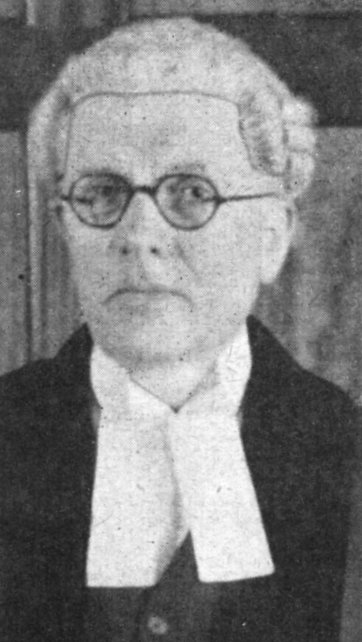
J. Brock Allon. |
|
First Duties
The first meeting of the Council,
which consisted of 12 Aldermen and 36 Councillors, was
held on the 22nd May, 1848. The duties of the Council
were confined to policing, markets, the making of
bye-laws and town improvement. Duties in relation to
sanitation followed two years later, The Council is
still responsible for all these, although that
responsibility increased as the town grew and as the
conception of the duties of a local authority changed.
For instance, the realisation that
a sound supply of water is essential for good health and
sanitation caused the Council to promote a private Bill
in Parliament in 1867 and the control of the water
supply of the Borough and some adjoining districts was
transferred from a water company to the Corporation.
This meant the establishment of a water department and
subsequent private Acts that have given the Corporation
an area of 83,385 acres to supply.
By that time, the Borough had been
granted a Commission of the Peace and a Court of Quarter
Sessions and two years later the Wolverhampton
Improvement Act defined and extended the Council's
powers in relation to the management of streets and to
sewerage, police and water supply. Following the passing
of this act, the Council began a big sewage scheme for
the town and Barnhurst Farm was purchased to receive
sewage.
Indifference
The influence of the Council in the
town's affairs was increasing. The visit of Queen
Victoria in 1866, when a knighthood was conferred on the
Mayor, had stimulated the interest of the citizens in
local affairs and the Improvement Act gave the Council
the ability to exercise that influence. But still every
fresh activity of the Council was received with
indifference, if not with hostility, and it was largely
due to the efforts of an ex-Mayor that the scheme was
put through.
Henry Hartley Fowler, who was later
to become Viscount Wolverhampton and Secretary of State
for India, was Mayor of the Borough in 1862-63. He
served on the Council for over 26 years and to his
influence can also be attributed the Council's decision
to acquire the control of the water supply. Following
the passing of the Elementary Education Act in 1870, his
speech to the Council pointing out the need for 3,000
more school places was largely responsible for the
Council's early application for the establishment of a
school board.
General legislation which was
passed in the 1870s gave to the Council new powers and
duties. A large area of land in the centre of the town
was purchased, old buildings were demolished and the
area re-planned and developed. The Council also
purchased the bath which stood on the site of the
Central Baths, which indicates the Council's growing
interest in the health of the inhabitants, for very few
houses were then equipped with baths. |
|

From an old postcard. |
|
First Park
However the Council was interested
in the health of the inhabitants in a wider sense, and
in 1879, they acquired the land on which the West Park
was later laid out. In 1889 the Art Gallery was erected
and presented to the Council by the late Philip Horsman
Esq. The Council as a patron of the arts was quite a new
role in those days. No doubt it was considered a luxury,
for it was not until the following year that the first
Infectious Diseases Hospital was opened.
Following the passing of the Local
Government Act in 1888, Wolverhampton became a County
Borough, since its population then exceeded 50,000. The
practical effect was to make the borough an
administrative county of itself and today it is one of
the 83 cities and boroughs which have this status.
In 1890 the Council was given power
to establish its electricity undertaking under the
provisions of an Electric Lighting Order. The Weights
and Measures Department was also established in that
year to take over duties which had till then been
performed by the police.
Transport and
Housing
The Borough celebrated its Jubilee
in 1898 and obtained a grant of a Coat of Arms from the
College of Heralds. The population was then over 90,000
but the Borough was still without public transport, or
municipal houses or control of its schools. However, two
years later the tramways were taken over by the
Corporation and within five years the first regular
motor bus service was running. At this time too, the
Council adopted a housing scheme and for the first time
assumed some responsibility for housing the people.
The Education Act, 1902, gave the
Council its great responsibility of education, although
the first meeting of the Education Committee which
superseded the School Board was not held until the 10th
July, 1903. The early years of the century were ones of
great activity and expansion in municipal affairs. The
library, which had been built to commemorate the Diamond
Jubilee of Queen Victoria was opened and a Maternity and
Child Welfare Service and a School Medical Service were
established.
This progress was arrested by the
1914-18 War, but on its conclusion the Council turned
its attention to the provision of houses in which task
it was encouraged by an Act passed in 1919, which placed
some of the financial burden on the Government. The
Council also took advantage of legislation at that time
to provide smallholdings and permanent allotments. |
|

From an old postcard. |
|
Borough Extension
More houses required more land, and
in 1926 the first Borough Extension Act for the borough
was passed, and on the 1st April of the following year,
the boundaries were extended by the inclusion of the
urban district of Heath Town, parts of the township of
Upper Penn, parts of the Parish of Bushbury and the
detached part of the Parish of Wrottesley.
With this extension, the size of
the Council was increased to 13 Aldermen and 39
Councillors. The Housing Department was set up in 1928
to manage the growing number of houses which were being
built to relieve overcrowding and to accommodate people
from houses which were being demolished under slum
clearance schemes.
Town Planning
The early thirties saw two
important tasks given to the Council. The Board of
Guardians which was responsible for administering the
Poor Law, was abolished and all those services such as
the relief of the poor and the maintenance of the
Cottage Homes, were transferred to the Corporation. Town
Planning was not a new idea to the builders of
Wolverhampton, as a walk through St. John's Square will
show, but an Act passed in 1932 gave to local
authorities for the first time, effective powers of
positive planning and the work of the Council in
correcting past mistakes and preventing new ones has
steadily increased since then.
In 1933 a further Borough Extension
took place following the passing of the Wolverhampton
Corporation Act, 1932, and parts of Upper Penn,
Wednesfield and Bushbury came into the Borough. So that
the new areas should be represented, the Council was
again increased to its present size of 15 Aldermen and
45 Councillors.
Further Scope
Shortly before the last war, the
scope of the Council's work was again enlarged. A
midwifery service was started in 1936 and under the
Wolverhampton Corporation Act of that year, the
Corporation took over the Cemetery in Jeffcock Road.
Both the Municipal Airport and the Civic Hall were
opened in 1938. War called a halt to developments of
this nature, although important tasks in connection with
the Civil Defence were given to the Corporation. The
British Restaurants which were established during the
war have now become permanent as Civic Restaurants under
post-war legislation. The Fire Brigade, which became
part of the National Fire Service during the war, again
became a municipal service this year. At the end of the
war, housing was an urgent concern of the Council and
great progress has been made.
At present the system of local
government is undergoing great changes; electricity,
hospitals and public assistance have been taken out of
the sphere of local government. The Local Government
Boundary Commission which is now sitting, is examining
the whole structure of local government to find the best
way in which it can be adapted to meet today's problems
and cover those services which have been re-organised on
a regional basis.
When we review the history of the
last hundred years we are encouraged to feel confident
that, whatever changes may be made, the people of
Wolverhampton will continue to elect representatives to
their Council who will, whilst deriving inspiration from
the traditions of the past, labour whole heartedly for
the advancement and well-being of the town in accordance
with the best principles of modern development. |
|
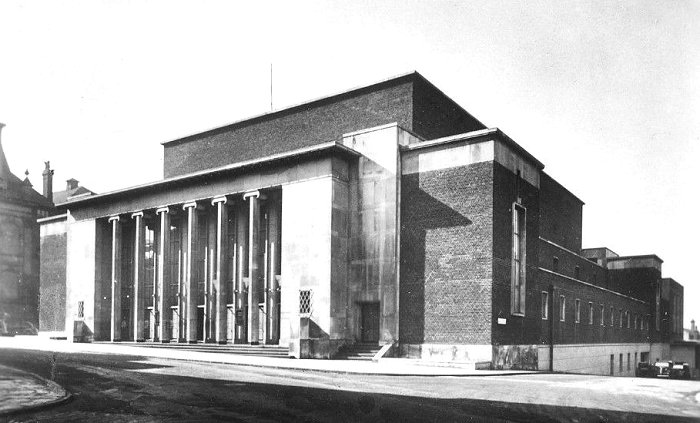
The Civic Hall. |
 |
Return to
the
previous page |
|